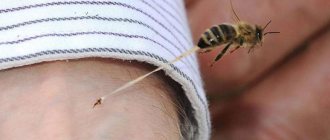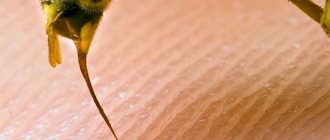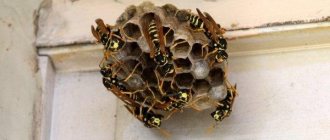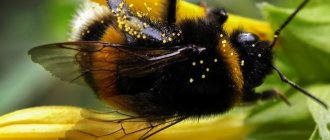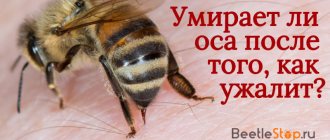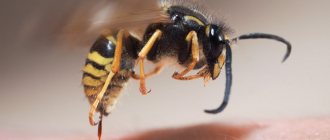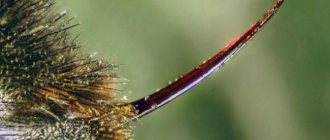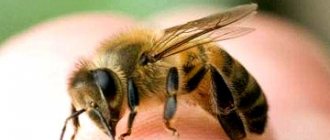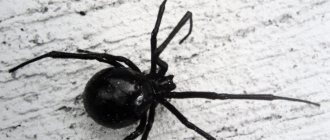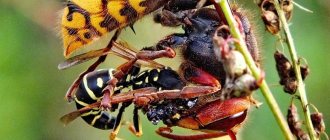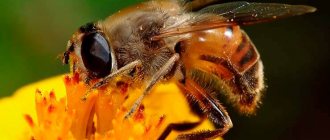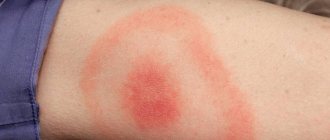A wasp's stinger is a modified ovipositor, so the males do not have such a formidable weapon, but does the wasp sting or bite? As a rule, the wasp family is mainly represented by females, so it is generally accepted that all wasps have a sting.
Many people know that the wasp has a sting, but not many know that only females are armed with it. With the help of its sting, the wasp protects itself from enemies and also attacks its prey.
What is a sting for wasps and bees and why is it needed?
According to Wikipedia, a stinger is the colloquial name for a pointed organ or part of the body of various animals and plants, used to inject a poisonous or burning substance under the skin of a victim (sting) or to deliver an electric shock (fortunately, this is not our case). The piercing of prey tissue occurs through the stinger's own movements, as opposed to other organs such as teeth (using the force of the jaws) or spines (using the movements of the prey). In our case, the sting is a modified ovipositor.
In social wasps, only one individual, the queen, lays eggs. Other females use the ovipositor to sting. Parasites and loners also sting with the ovipositor, and they also leave offspring (loners in separate nests, parasites in the victim). But males do not have an ovipositor, and therefore do not have a sting. Alas, this does not make our life easier. Male wasps are only found during the mating season—a couple of weeks in late summer or early fall.
Reproduction and lifespan
The queen, well-fed after hibernation, makes the first clutch of eggs in the spring. Only sterile wasps emerge from it - they are intended to continue building the nest and obtaining food.
And only at the end of summer are eggs laid, from which larvae emerge that are capable of reproducing in the futureWhen the wasps grow from the larvae, they begin to swarm, mating with each other. As soon as fertilization has occurred, pregnant females fly away from the nest one by one in search of a suitable warm winter shelter
With the onset of the cold season, the males and the entire previous swarm, led by the old queen, die. In the spring, the new queen, in turn, will build her own nest
The female wasp mates only once and brings more than 2000 larvae, most of which will become infertile - working individuals.
This clutch is sealed into a chamber with small insects left in it as future food for the larvae.
But wasps feed the larvae, from which individuals capable of reproducing will grow, differently. They are brought food that promotes the development of genital organs.
Wasps do not live very long - the life of the queen is 10 months, and the life of drones and workers is 4 weeks.
Wasps of various species live everywhere, because they can get food anywhere, but most of all they like to settle next to human habitation - because here you don’t have to make much effort to find food.
Wasp bites or stings
In fact, they can bite and sting. They only bite with the help of their jaws, but sting with the help of this very modified ovipositor. The wasp's supply of poison is not unlimited (1-1.5 milligrams) and is replenished slowly. And the ovipositor itself is not so strong, so wasps only sting soft integuments, and bite through hard ones with toothless but very powerful jaws.
Wasps also need their jaws for feeding larvae. Adult wasps feed only on liquid and soft food: nectar, honeydew, honey, sweet droplets of resin or juice, and some on insect hemolymph (their analogue of blood). They are not interested in human or animal blood - it does not suit the composition. Wasp larvae eat solid and exclusively non-vegetarian foods. Their parents hunt spiders, flies and small beetles for them. They poison the victim with poison, chew it and feed the larvae with this porridge.
It is the person who gets stung - he is quite soft. However, they sting not for no reason, but to protect their interests:
- driven away from the nest,
- compete for a berry or flower,
- react to panicky waving of hands or a strong aroma of perfume.
Bite or sting?
Despite the fact that the word “bite” is more often used to denote this action of a wasp, it is better to replace it with the word “stinging,” since it is the sting that the insect uses for this. In the strict sense, it does not bite, since it has no teeth.
Wasps do not specifically attack animals or humans; this is a defensive reaction when the insect believes that it is in danger. It can bite if you crush or disturb an individual, accidentally frightening it. If the wasps notice a person near the nest and consider that this is a danger, they can attack him with the whole family.
Detailed anatomy of a sting under a microscope
A wasp sting under a microscope.
The wasp's sting is smooth and easily pulled out, so the attack can be repeated several times in a row.
The ovipositor is transparent and consists of two grooves - stylets. The eggs roll inside the grooves. The stylets are hidden in the abdomen under the plates and, when necessary, move outward - they slide down a special channel, a slide.
Having become a weapon of defense, the ovipositor hardened and connected with the poisonous gland. If necessary, special muscles contract and squeeze out about a quarter of the reserve of poisonous secretion. It flows down the outer walls (the inner gutter is for eggs only). If the insect is quickly thrown off, the poison may not get under the skin.
All wasps have a smooth sting that is easy to pull out. This is a vital necessity: if the sting remained in the victim, there would be nothing with which to lay eggs. When the queen of social wasps dies, the worker wasps leave their offspring until they hatch a new queen.
Note the serrations on the bee sting. Looks more like a prison.
This is the fundamental difference between the sting of a wasp and a bee. Bees have notches or notches along the entire length of their sting. They leave a sting in the enemy’s body along with a nerve ganglion and poisonous reservoirs, so even after the death of the insect it continues to move and inject the remaining poison from the poisonous sac into the enemy for another 20 minutes.
The only bee with a smooth stinger is the queen bee. No other bee can perform its functions, so the rest use unnecessary ovipositors more efficiently.
Why do wasps bite?
It should be remembered that the wasp is an aggressive insect, and often it seems to us that the attack occurs for no apparent reason.
But this is not so - a person is not interested in the wasp until he takes the following actions:
- is too close to a wasp nest - insects diligently protect their home and are ready to attack if threatened;
- makes sudden movements when scared away - can be perceived as a threat;
- spreads heavy floral scents of perfume or wears brightly colored clothes - this can irritate insects;
- tries to swat the insect - in this case it will immediately try to bite;
- gives in to panic - while remaining calm and not making sudden movements, you should move away from the danger zone.
If you do not act in the above ways, then you can live calmly and without trouble in the vicinity of insects.
Did you know? Wasp venom is able to destroy cancer cells without affecting healthy ones.
How does the sting work during a wasp attack?
If you doubt whether a wasp has a sting, put on a thick glove and catch it by its wings, and then press on its abdomen. The sting will be pulled out with each press and then hidden back.
It looks like this video:
During an attack, 0.3-0.4 mg of poison gets under the skin. Since the venom flows down the outer walls of the stinger, it is necessary that it penetrates deep into the skin, otherwise the attack will be ineffective. How many times does a wasp sting? Until all the poison is used up. 4-5 times if the bites find a target, and several hours if you simply provoke the sting to be pulled back and forth in laboratory conditions.
Main types
The wasp insect is often familiar to us from photographs. But besides the standard one with a striped yellow and black belly, there are other varieties. Wasps can be solitary or live in groups. They can also settle in different areas.
The road wasp makes a nest in the ground or even inside the corpse of a prey it has killed previously (for example, it could be a spider). The body of the dead insect will then become food for the emerging offspring.
Everyone is familiar with paper wasps, which we often see on the street in the summer. They are named so because to create nests, these species use a thin material that resembles paper in properties. And they produce it themselves, mixing their saliva with wood dust.
Wild wasps, on the contrary, settle away from people. They can often be found in the forest.
It’s interesting that a new trend has emerged today – house wasps. Some people get a dog or a cat, while others are interested in watching the life of insects. To keep such wasps, special closed aquariums are used. They are beautifully designed and look very stylish. But such a “pet,” of course, is not for everyone.
When an insect leaves a sting when biting
Only the bee leaves a sting when biting, since only it is all serrated. It clings to the skin and remains in the wound along with the poisonous reservoir. This reservoir has autonomous muscles, which, even when separated from the body, contract for another 20 minutes, injecting the remaining poison under the skin. There is logic in this: even if the bee is brushed away or crushed, the poison will still enter the enemy’s body. Actually, a bee always dies after stinging. But the loss of one soldier in an army of ten thousand is not terrible, but the enemies of the hive can be large (remember bears), and they must be neutralized quickly and reliably.
Does the sting remain?
Wasps' stings do not have serrations, like bees', and are completely smooth. After being stung by an insect, it can pull it back without any consequences for itself. The wasp does not leave it in tissues and can be reused.
Different wasps, different stings, different bites
Wasps, hornets, bees, gadflies - they all bite differently and the consequences of the bites are not the same.
In fact, it is an ordinary parasite.
Gadflies are the nastiest - they bite off a piece of skin and try to lay eggs inside. The wound has favorable conditions for young animals.
Hornets and bees bite equally painfully and are equally scary for allergy sufferers. For non-allergic people, a hornet sting is useless, it hurts a lot and only causes inconvenience, unlike a bee sting, which is healing. Bee venom normalizes blood pressure, strengthens the immune system and blood vessels, dissolves cholesterol, improves memory and metabolism. The only disadvantage of bee stings is that the bitten person is marked with pheromones and becomes an enemy for all bees flying past, so it is better to retreat immediately - numerous bites are life-threatening.
The sting of a common wasp causes swelling and redness, but if you do not scratch it, it goes away in a couple of days. Other wasps are even less dangerous. The scolias produce little venom, the bite site goes numb for a couple of hours - and everything goes away without a trace. Philantines only bite through delicate skin, so you can safely smack them with rough palms.
Other types of wasps prefer not to enter human territory. You can meet them in the wild - on a picnic or on a hike. If you don’t have an antihistamine with you, you can reduce the effect of wasp venom with improvised means - any sour product: lemon, sour berries, sorrel... It will be good to apply cold, drink more and get back to civilization.
How dangerous is the poison?
The insect is dangerous because its poison can cause a severe allergic reaction, even leading to death. Many people are unaware of their high sensitivity to this poison until the moment they are bitten. Although wasps sting quite often. The bite is accompanied by sharp pain, the wound swells, and a burning sensation is felt. This is the least you can get away with in such a situation. The consequences may be unforeseen.
The poison contains substances such as:
- phospholipase;
- melitin;
- histamine, etc.
The whole difficulty lies in the fact that without encountering a wasp, it is impossible to know about the presence of sensitivity to these substances. Therefore, an attack by a stinging insect can lead to unpleasant consequences and even death, although this is a very rare occurrence.
The properties of substances also include:
- destruction of body cells;
- causing tumor;
- triggering allergies;
- impact on the nervous system.
It is because of the action of the poison that the bite site becomes inflamed and does not heal for a sufficiently long period of time. Itching may also add to the pain. If the pain does not go away after 2 weeks, it is best to consult a doctor.
How much and how long the wound hurts may depend on the type of insect that stung. The bite of some individuals may be completely painless, while others will lead to suffering.
Most bites occur on the arms and legs. But cases of stinging in the head also occur. If the sting gets into the face, it may change beyond recognition. The eyelids swell to such a size that the eyes cannot see anything. Bites on the tongue often occur. This happens when a wasp sits on food, but a person did not notice it and took it into his mouth. The swollen tongue becomes so large that the mouth may not close.
Degree of toxicity of the poison
Regardless of the type of wasp, the structure of the sting has identical characteristics, but the nature of the bite and the consequences depend on the toxicity of the poisonous secretion.
- The hornet is the largest wasp and its sting is quite painful. In addition, the hornet has a fairly toxic poison that can seriously harm human health. The Asian hornet kills a person prone to allergies in a few minutes. Every year, up to 50 people die from hornet stings in countries such as Japan and China. The nature of the bite is comparable to the penetration of a hot nail into a person’s skin. There are no such dangerous insects in our territories, but a person can die after 5 bites of such insects if help is not provided in a timely manner.
- Scolia giants are also among the largest wasps on the planet. It should be noted that their sting is small, and the poison is not toxic to humans. In the case of a scolius bite, short-term numbness of the bite site is possible, for several minutes. Only allergy sufferers or children who still have a weak immune system can suffer from a bite of this species. These insects are not aggressive, so they prefer not to participate in various conflict situations, including with humans. In addition, scolias are not considered social insects and do not live in large families, so numerous insect bites are not a threat.
- Philants are among the most harmless creatures representing the wasp family. They live deep in the earth, in burrows they have dug. These insects also have a second name - bee wolves, since adult individuals are capable of destroying bee colonies, since bees form the basis of their diet. The larva eats 5 bees to become an adult. As a rule, bee wolves attack their prey in flight, inserting a stinger into it, which leads to paralysis of the insect. After this, they eat their prey or take it to their nest. Philants live in the ground, and they can easily find their nest at any distance.
- Pompylids are wasps with a long sting and a potent venom. Therefore, the bites of these wasps are quite painful. These insects are quite aggressive and attack at the slightest sign of aggression towards them. More than 150 species live on our territory. Adult individuals grow up to 3 cm in length and lead an isolated lifestyle, without creating nests or numerous families. Eggs are laid on spiders. After hatching, the larva eats the spider from the inside. The sting of these aggressive insects is quite powerful and strong.
It is very important to know what to do if a wasp does bite you. This is especially true in relation to those people in whom the body reacts very violently to the action of insect poison, causing severe consequences, and sometimes even fatal.
